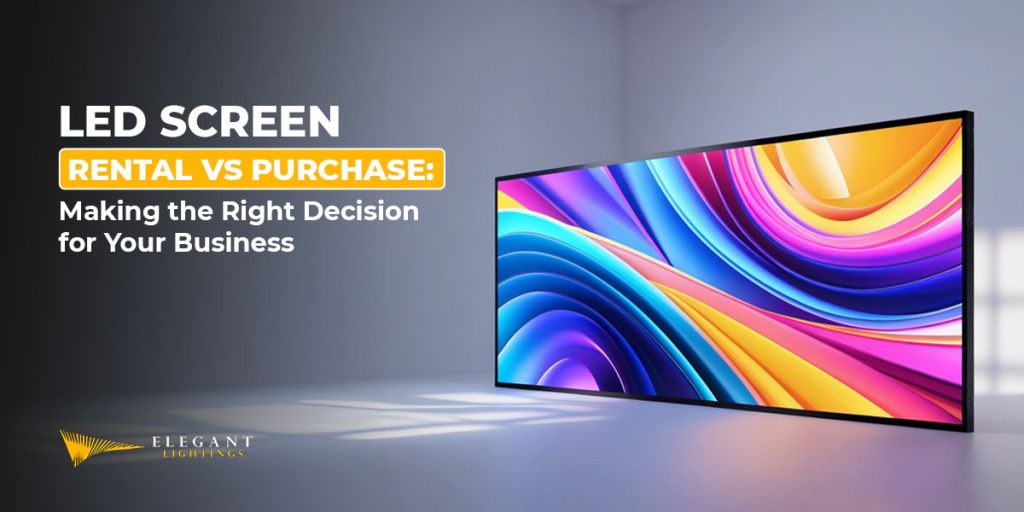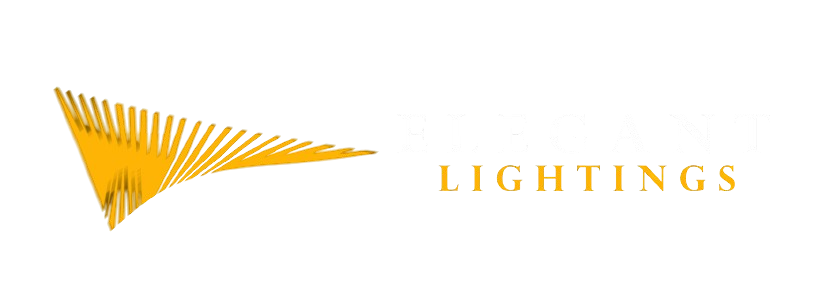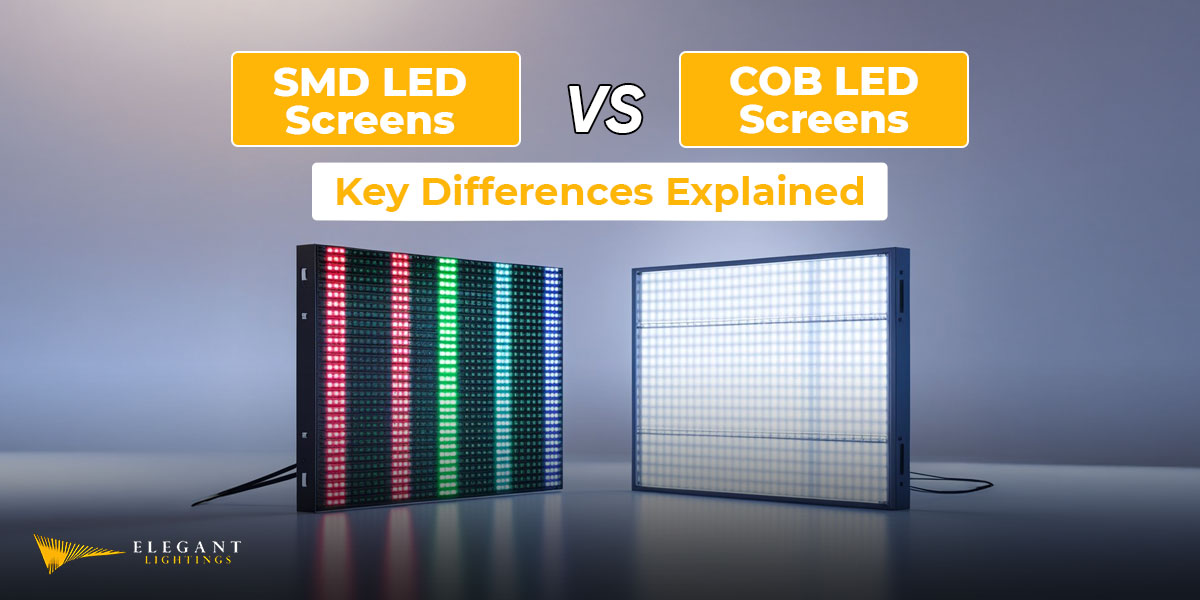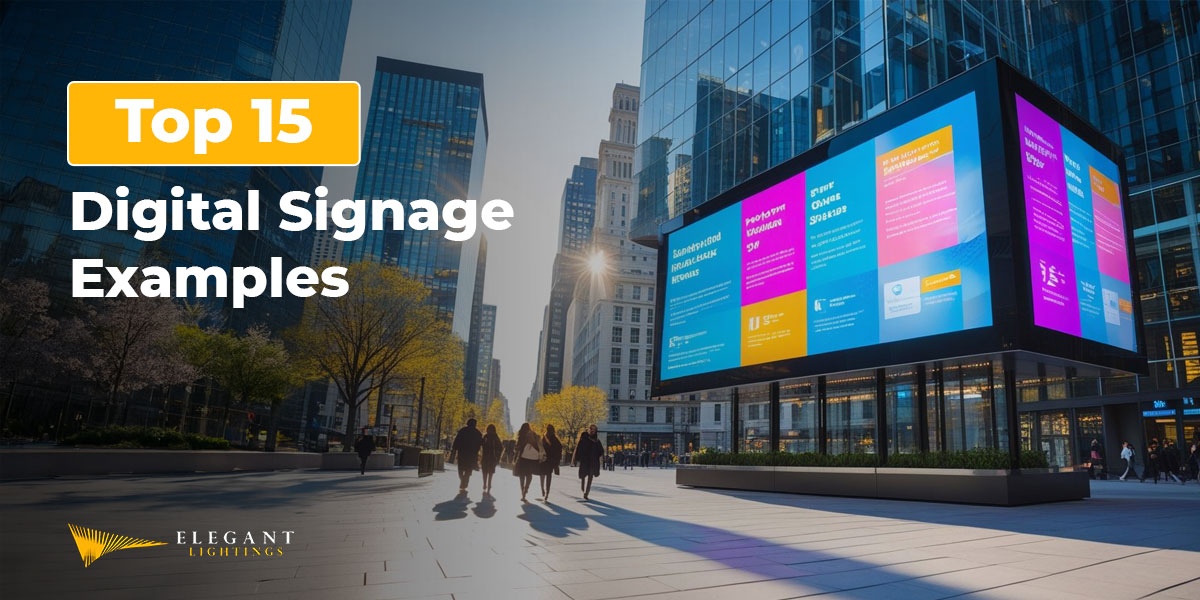The LED display market is projected to reach an impressive $12.5 billion by 2027, and it’s no surprise why.
What's on this page:
Businesses across the United States and beyond are leveraging this technology to create unforgettable experiences, boost engagement, and drive revenue.
But when it comes to acquiring LED screens, the fundamental question remains: should you rent or buy?
At Elegant Lightings, we’ve helped countless businesses navigate this exact decision!
In our experience, the right choice depends on your specific needs, budget, and long-term goals.
In this post, we’ll break down everything you need to consider to make the best decision for your organization.
Let’s dive in!
Understanding Your Options: Rental vs Purchase
First, let’s quickly understand what renting and purchasing LED screens mean for you:
1. LED Screen Rental: Flexibility and Immediate Access
Renting an LED screen provides temporary access to high-quality display technology without long-term commitment. This option is ideal for short-term needs where flexibility and cost-effectiveness are your priorities – for eg, for one-time events or event management companies operating across the United States.
2. LED Screen Purchase: Long-Term Investment
Buying an LED screen represents a significant capital investment but offers permanent access to display technology. This option makes sense for organizations with frequent or ongoing needs for visual displays – for eg, for company-owned retail stores, advertising billboards, art galleries, event arenas, or sports stadiums.
Buy or Rent LED Screens: Key Factors to Consider
Next, let’s break down the key factors that you should consider to make the choice between buying and renting LED screens:
1. Frequency of Use
How often you plan to use LED screens is the most critical factor in your decision.
For instance, if you host events less than three to four times per year, renting is generally more economical.
In fact, many of our Los Angeles clients find that renting for occasional events costs 40-60% less than purchasing equipment that would sit unused most of the time.
For regular use – weekly presentations, permanent installations, or frequent events – purchasing can end up becoming more cost-effective over the long run.
The break-even point typically occurs around 34 uses per year, making ownership financially advantageous if you plan on using your LED screens consistently.
2. Budget Considerations
Your LED screen budget will significantly impact the rental versus purchase decision.
Renting requires less upfront capital, with costs typically ranging from $500 to $5,000 per day, depending on screen size and specifications. This approach preserves cash flow and converts what would be a capital expenditure into an operational expense.
Purchasing involves a substantial initial investment – often between $10,000 and $50,000+ for complete systems.
However, you should keep in mind that while the upfront cost is higher, ownership will eliminate recurring rental fees and can offer better long-term value for frequent users.
3. Technical Expertise and Support
Consider your in-house technical capabilities. Rental companies typically provide comprehensive services, including setup, calibration, and technical support throughout your event.
This support can be especially invaluable if you don’t have or don’t want to create a dedicated AV department in your organization.
On the other hand, when you purchase an LED screen, you’re responsible for installation, maintenance, and repairs. Of course, you can always contract these services separately!
Simply put, purchasing LED screens means you’ll either have to develop in-house expertise or build relationships with reliable technical partners.
4. Storage and Transportation
LED screens require proper storage conditions when not in use, including climate control and secure facilities.
Rental agreements eliminate these concerns, as the rental company handles storage and transportation.
But if you own your LED screens, you’ll be responsible for these logistics, which can add significant costs.
For example, storage alone can amount to about 40% of rental fees over three years.
5. Technology Updates
LED technology evolves rapidly, with new features and improvements constantly emerging. Renting allows you to access the latest technology without worrying about obsolescence.
When you purchase a screen, you risk owning equipment that may become outdated within a few years.
However, you won’t have to worry about your LED screen breaking down – with minimal maintenance, both indoor and outdoor screens can last up to 10 years.
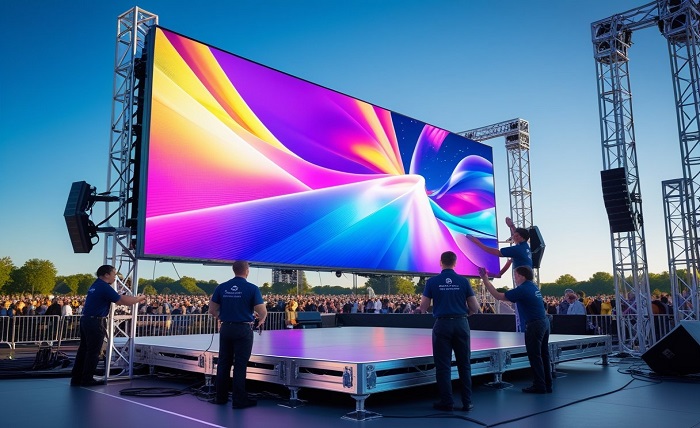
Buying vs Renting LED Screens: Cost Comparison Analysis
| Cost Factor | Renting | Buying |
| Initial Investment | Low ($500-$5,000/day) | High ($10,000-$200,000+) |
| Maintenance | Included in rental cost | $500-$1,200/year |
| Transportation | Typically included | ~$0.60/sq ft/mile |
| Storage | Not your responsibility | 40% of rental fees over 3 years |
| Technology Updates | Access to the latest models | Additional upgrade costs |
| Long-term Value | Cost-effective for infrequent use | Better ROI for frequent use |
Statistical Insights: The LED Display Market
To make an informed decision, you might want to check out the most important trends in the LED display market:
1. The US Market
The U.S. The LED display market is projected to reach $6.8 billion by 2027, driven by high demand in events, advertising, and religious institutions.
2. Better Option for One-Time Events
Studies and surveys suggest that renting LED screens is 40-60% less expensive than purchasing for one-time events.
3. The Break-Even Point
Businesses that use LED screens more than 34 times per year typically find purchasing more cost-effective. So, the break-even point for purchasing versus renting is typically around 34 events per year.
4. Impact on Brand Awareness
Dynamic video walls can boost brand awareness by up to 48%, making them ideal for advertising businesses or company-owned stores.
5. Impact on Sales
Interactive digital signage has been shown to increase sales by as much as 30%.
6. Depreciation Rate
LED displays depreciate approximately 35% annually when owned, compared to 12% for rental units.
7. Average Brightness Levels
Outdoor LED units typically feature high brightness levels (≥5000 nits) and IP65-rated weatherproof designs. This means they can last up to 10 years, even in harsh weather conditions (however, they might require periodic maintenance).
8. Color Calibration Costs
Color calibration costs for owned displays average $1.11 per square foot per month, compared to $0.28 per square foot per use for rentals.
9. Modular Systems = Increased Lifespan
Modular LED systems allow for customization and upgrades, extending the lifespan of purchased equipment.
Recommendations by Use Case
Still not sure whether to buy or rent?
No problem – check out our recommendations based on different uses cases to see if it helps you make a decision:
1. When to Rent LED Screens
- One-time events such as weddings, concerts, or special celebrations.
- Seasonal promotions or short-term marketing campaigns.
- Testing LED technology before making a purchase decision.
- One-time or limited-period events with specific technical requirements.
- Situations where budget constraints prohibit large capital expenditures.
2. When to Buy LED Screens
- Regular corporate, entertainment, sports, religious, or other events + requirements.
- Permanent installations in retail spaces, lobbies, or command centers.
- Organizations hosting more than 10-15 events annually.
- Long-term projects requiring consistent branding and customization.
- Situations where quick access and total control are priorities.
The Hybrid Approach: The Best of Both Worlds
For some organizations, a hybrid approach offers the ideal solution.
Consider purchasing a standard-sized screen for regular use while renting additional or specialized equipment for larger events. This approach optimizes costs while maintaining flexibility.
For example, you might own a medium-sized screen for weekly presentations but rent additional panels for an annual conference or special event.
Environmental Considerations for Buying vs Renting LED Screens
Sustainability is increasingly important in business decisions.
Renting LED screens promotes resource sharing and reduces electronic waste, as equipment is utilized across multiple events rather than sitting idle between uses.
Rental companies also typically update their inventory regularly, ensuring energy-efficient technology is used.
If purchasing looks like the best option for your organization, we suggest going for energy-efficient models that slash the costs and reduce emissions at the same time.
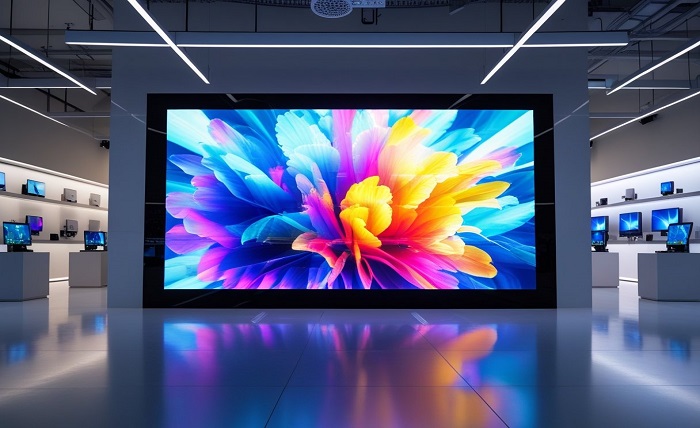
Making Your Decision: A Step-by-Step Approach
Here’s a list of questions/factors that you should consider before making your final decision:
- Assess your usage needs: How often will you use the screen? What technical specifications does your event require?
- Evaluate your budget: What upfront investment can you make? What are your long-term financial goals?
- Consider your technical capabilities: Do you have in-house expertise for setup and maintenance?
- Examine your storage options: Do you have adequate space to store equipment when not in use?
- Think about technology needs: How important is access to the latest display technology?
- Consider customization requirements: How much control do you need over the display’s configuration and branding?
- Calculate the total cost of ownership: Compare rental costs over time versus purchase price plus maintenance.
Buy or Rent Your LED Screens from Elegant Lightings!
The decision between renting and buying an LED screen depends on your specific needs, budget, and long-term goals.
Renting offers flexibility, lower upfront costs, and access to the latest technology – ideal for occasional use or short-term projects.
Buying provides long-term value, complete customization, and constant availability—perfect for frequent use or permanent installations.
At Elegant Lightings, we understand that every business has its unique requirements.
Whether you’re leaning towards rental LED displays or permanent acquisitions, we’re here to help you make an informed decision that maximizes your visual impact and return on investment.
Remember, the right choice isn’t just about cost: it’s about finding the solution that best supports your communication goals and enhances your audience’s experience.
Looking for personalized advice? Connect with our expert LED engineers today to discuss your specific needs and find out how our LED solutions can light up your next project!
LED Screen Rental vs Purchase: Frequently Asked Questions
1. How much does LED screen rental cost in Los Angeles?
LED screen rental costs in Los Angeles typically range from $500 to $5,000 per day, depending on size, resolution, and rental duration. Most suppliers offer package deals that include delivery, setup, and technical support.
2. What is the average cost of purchasing an LED video wall?
Complete LED video wall systems range from $10,000 to over $50,000, with larger installations sometimes exceeding $100,000. The average initial cost is about $167 per square foot.
3. How often do I need to use an LED screen for purchasing to make financial sense?
The break-even point is typically around 34 events per year. If you use the screen more frequently than this, purchasing usually offers better long-term value.
4. Can rented LED screens be used outdoors?
Yes, many rental companies offer outdoor LED screens with weather-resistant features. These typically have high brightness levels (≥5000 nits) and IP65-rated weatherproof designs.
5. What technical support is included with LED screen rentals?
Most rental companies provide comprehensive technical support including delivery, installation, operation during the event, and teardown. Some offer 24/7 support for multi-day events.
6. How long does it take to set up a rented LED screen?
Setup time varies based on the size and complexity of the display, but professional installers can typically complete the process efficiently. Many rental companies design their systems for quick assembly with features like quick locks and connectors.
7. Can I customize a rented LED screen?
While rental screens offer some flexibility in configuration, customization options are limited compared to owned systems. Most rental companies provide standard sizes and specifications.
8. What maintenance is required for purchased LED screens?
Owned LED screens require regular maintenance including color calibration, cleaning, and occasional repairs. Annual maintenance costs typically range from $500 to $1,200.
9. How often should I upgrade my purchased LED screen?
LED technology evolves rapidly, with significant improvements every 2-3 years. However, well-maintained screens can remain effective for 5-7 years before needing replacement.
10. Are there tax implications for purchasing versus renting?
Purchasing LED equipment is treated as a capital asset that can be depreciated over time, while rental costs are typically treated as operational expenses.


